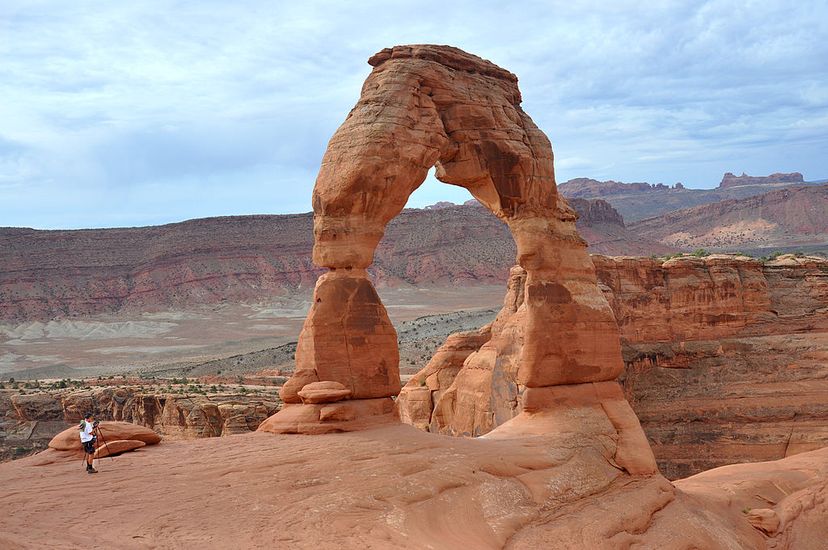
Advertisement
A Wondrous Red Rock Landscape
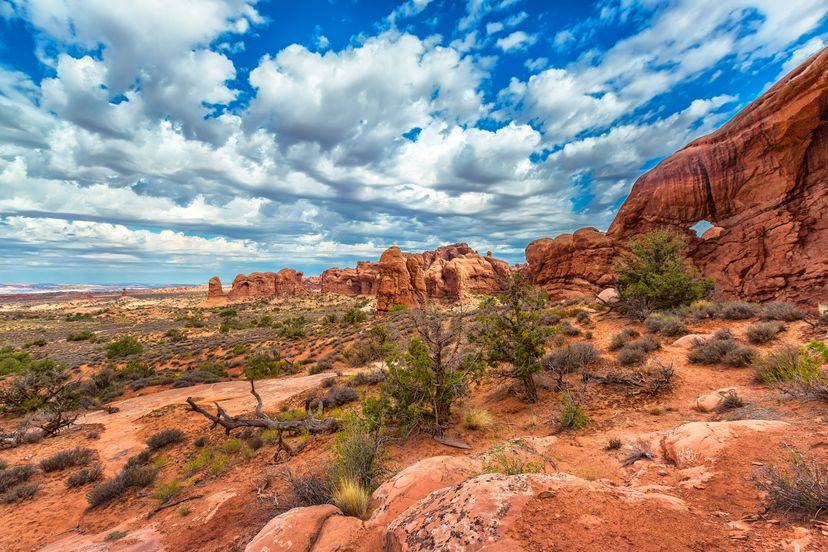
Where is Arches National Park? Home to more than 2,000 sandstone arches, natural bridges, towers, rock fins, and other awesome formations, Arches National Park is a great place to take in the wonders of Utah, hike its scenic trails, and explore its canyons.
From ancestral foraging and hunting grounds to the rugged frontier to tourism hot spot, Arches has shared a variety of special relationships with humans throughout its history. In the last century, the citizens of nearby Moab have worked to promote the park not only as a symbol of the city but also of Utah itself.
Delicate Arch, the most widely-recognized landmark in the park, has appeared on Utah’s license plates and postage stamps. Interestingly, it and many more of the park’s famous sightseeing spots were not included in its original land grant, when it was founded as Arches National Monument in 1929.
However, expansions of the park’s territory protect more than its iconic rock features — Arches National Park’s delicate, intricate ecosystems are home to an abundance of specially adapted wildlife, including some species on the road to recovery.
Facilities at the park are somewhat limited. If you’re looking to camp out in Arches, it’s advisable to make a reservation. Additional accommodation and amenities can be found in and around Moab.
Activities in Arches National Park
Stargazing
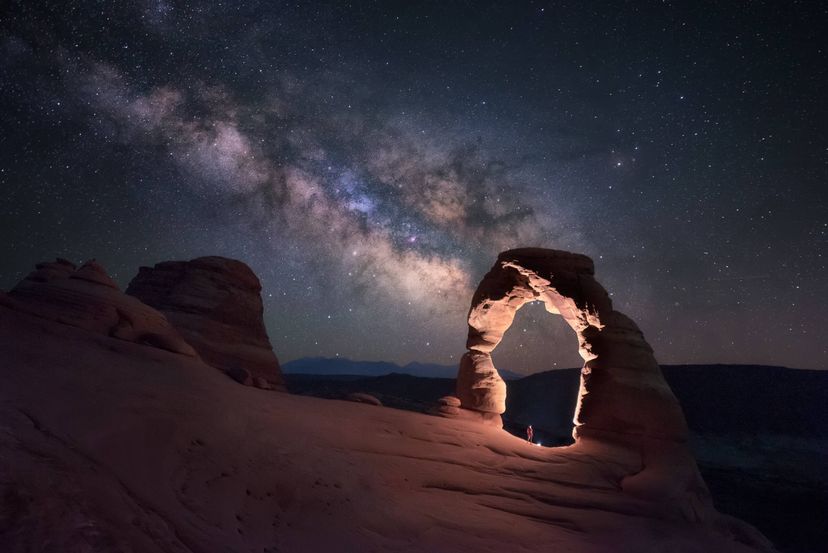
Modern life grants us many comforts, but it also robs us of some of life’s simplest, most beautiful pleasures. Perhaps that’s why so many people seek out the natural grandeur of national parks: to reconnect with a more primitive version of ourselves, to feel awe at the sublimity of nature once again.
At Arches National Park, it’s not hard to get absorbed in the beauty of the high desert during the day. But at night, there’s even more to behold. The thin, moisture-sparse desert air and relative lack of light pollution in and around Arches make for excellent stargazing. Nearby Dead Horse Point state park and Canyonlands National Park also offer great opportunities for watching the night sky.
Hiking, Climbing, and Canyoneering

Arches have a plethora of hiking trails for a range of skill levels. These trails will let visitors get very close to the park’s awesome rock formations. If you bring a camera on your hike, be sure to take advantage of prime lighting times in the early morning and late afternoon, when the sandstone will appear aflame with amazing hues of red. Just remember to stay on the marked path, and observe conditions and safety regulations.
Easy trails include short loops to Delicate Arch, Double Arch, the Windows, and other popular vistas, which are great for families. Moderate trails get a little steeper and can wash out after rainfalls. Long trails trek over sandstone slabs and another rugged terrain through Devils Garden and Fiery Furnace. If you’re not taking a ranger-led tour of Fiery Furnace, you’ll need a backcountry permit.
Due to the sandy desert soil, rock climbing in Arches National Park can be quite challenging. Knowledge of advanced techniques is requisite for scaling a number of the park’s most popular ascents. There are important restrictions that apply to climbing in the park. Some are seasonal, some are permanent. For instance, climbing of any kind on any arch or natural bridge named in the USGS 7.5 minute topographical maps of Arches National Park is strictly prohibited. Similar restrictions apply to canyoneering in the park. Dragonfly and Teardrop are two popular technical (involving the use of climbing and rappelling equipment) canyoneering areas in Arches National Park.
Advertisement
Auto Touring and Biking

Auto touring is a convenient way to take in the scenic vistas of Arches National Park, but since the park’s seen a recent uptick in visitation — reaching 1 million visitors for the first time in 2010 — traffic can be an issue, particularly on weekends and holidays. The park’s website provides common-sense tips on avoiding crowds and traffic. Parking in at trailheads is limited, so it’s a good idea to have a backup plan. Biking is a great alternative to car travel, provided you’re in good shape. Since bikers and cars must share the road, it’s a good idea for cyclists to set out earlier in the day, when traffic is lighter.
Visiting Arches National Park
Seasons, Fees, and Reservations
Arches National Park is open every day of the year, but visitor services within the park are limited. Lodging, gas, food, and other services are available in nearby Moab. While Arches National Park can receive less than 10 inches of rain per year, its temperature varies greatly between seasons. Temperatures at the height of summer can exceed 100 degrees Fahrenheit, whereas winter lows often dip well below freezing. Temperatures can range more than 50 degrees in the space of a day.
The standard entry fee at Arches National Park, which is good for seven consecutive days, costs $10 per vehicle and $5 per person for visitors arriving on foot, bicycle or motorcycle. Special passes include a local passport option, which grants the bearer one year of access to Arches and Canyonlands National Parks, and Hovenweep and Natural Bridges National Monuments. Check out the park’s website for more information on fees.
Reservations at Devils Garden Campground are not handled or accepted by Arches National Park, nor does the park keep information about site availability. Campsites at Devils Garden cost $20 per night. Backcountry use permits are required for all overnight stays in the backcountry, and for any expeditions in Fiery Furnace excepting those led by a ranger.
Sandstone Arches
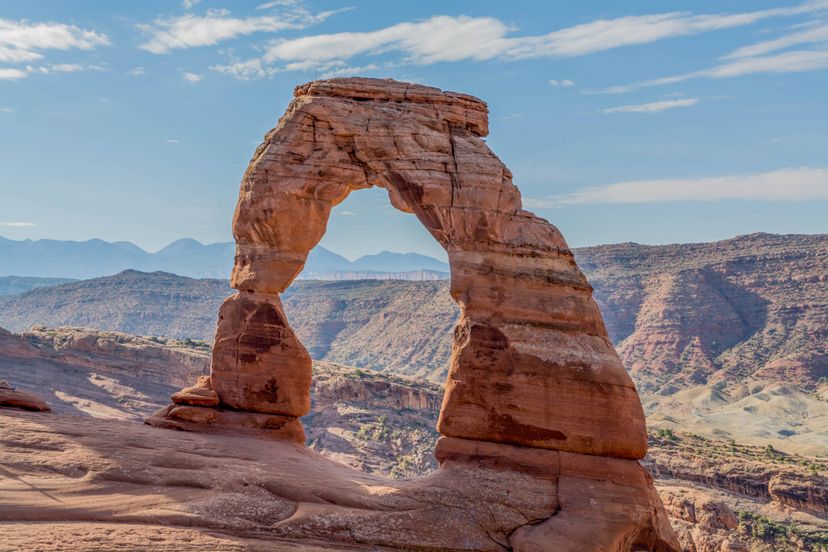
More than 2,000 sandstone arches give this park its name, and many of them are viewable on scenic hikes. Sometimes, hiking trails lead right under arches, affording visitors a spectacular perspective on these natural wonders. The arches were created through erosion of rock that once formed the bed of a great inland sea. The sea evaporated, leaving salt deposits that helped shape the dramatic balancing boulders, arches, spires, and fins of rock that have made the region famous.
The not-to-be-missed rock formations in Arches National Park include Delicate Arch, which has become a symbol of the state of Utah, and Balanced Rock, a boulder the size of three school buses that sit on a spire nine miles from the park’s entrance.
The Good Earth
Much of the high desert in Arches National Park is covered in biological soil crust, a blackish layer of lichens, mosses, algae, and cyanobacteria that provides two important services to the desert ecosystem. The living carpet binds together the loose desert soil, providing an effective shield against wind and water erosion. Additionally, the organisms in the crust enrich the soil by converting nitrogen in the atmosphere into a form that plants can use as food.
Both these processes are vital to the desert ecosystem, so it is important for visitors not to disturb the biological soil crust by trampling it. Damage to the crust, especially when it is dry and brittle, can take a very long time to heal, if they recover at all. Visitors should always drive or ride on designated roads and follow marked trails when hiking.
Advertisement
Wildlife in Arches National Park
Contrary to what most people might assume, the desert habitat of Arches National Park is teeming with animal life. The catch is that lots of species, particularly mammals, lay low to avoid the heat during the day. Still, it is possible to spot a glimpse of some of the Arches’ many native critters — you just need to know when and where to look.
Collared Lizard
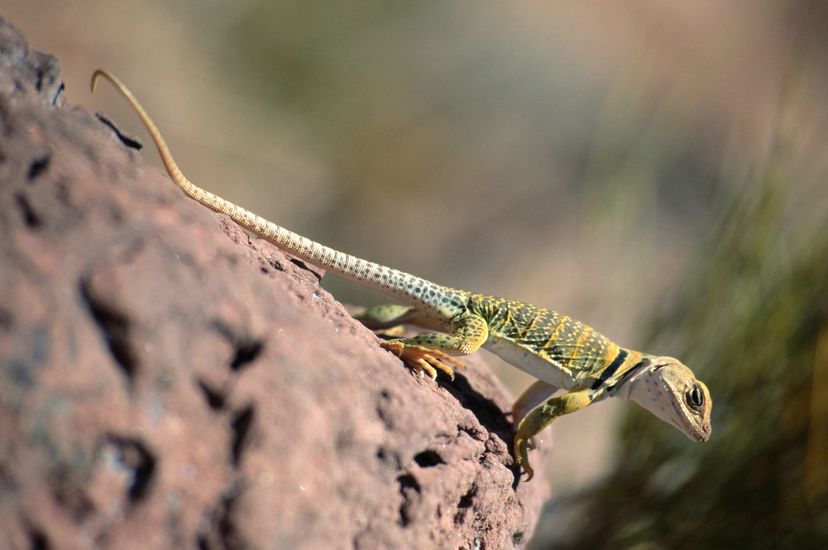
Like all cold-blooded animals, the collared lizard depends on its environment to regulate its body temperature. So while many animals that live in Arches National Park won’t show themselves during the day, you can count on seeing it and other lizards basking in the sun. The collared lizard is named for a dark band around its neck, but wildlife spotters will definitely notice its brilliant colors, teal with bright yellow markings. Catch it on the hunt for insects and small vertebrates — you might even see it running on its hind legs!
Desert Bighorn Sheep

As its name suggests, desert bighorn sheep are specially adapted for life in arid regions. A distinct subspecies, they have smaller bodies, longer legs, and thinner coats than their mountain-dwelling cousins. They can also go for days without water. These sheep were commonly featured in Native American pictographs throughout the southwest, a testament to their importance to those societies.
Although once common and quite numerous, desert bighorn numbers dwindled by the end of the 19th century, due to hunting and diseases borne by domesticated sheep introduced by ranchers. The National Park Service reintroduced desert bighorn sheep to Arches and other parks in Utah starting in the 1980s. Researchers now estimate a statewide population of 3,000. You can see desert bighorn sheep along Highway 191 south of the Arches visitor center.
Kangaroo Rat

The desert favors small mammals like rodents, who require little water and can readily find shelter from the intense elements. There are eleven species of mice and rats in Arches National Park, but perhaps none better adapted to desert life than the kangaroo rat. This rodent, which gets its name because it hops around on its hind legs like a kangaroo, lives in a complex burrow system underneath the loose desert soil. Each den within the burrow serves a specialized purpose, from food storage to sleeping. To trap moisture in the burrow, kangaroo rats plug the entrances with loose dirt during the day and stay underground. While this means that they’re not too common during hot days, you’ll likely be able to tell they’ve been around by the tracks that the rats leave in the soil.
History of Arches National Park
Advertisement
Native Peoples
The first humans to inhabit Arches National Park were hunter-gatherers that came to the area to make tools like knives, darts, scrapers, and spear points from the microcrystalline quartz commonly found in the region. Eventually, these paleolithic forebears would come to practice agriculture, cultivating crops like beans, squash, and corn in the arid soil. These agrarian societies would develop into the Ancestral Puebloan and Fremont cultures, which were prevalent throughout the southwest until about 700 years ago.
Located on the northern fringes of the Ancestral Puebloan lands, Arches National Park does not have any ancient dwellings, but it does retain other important records of human activity, such as inscriptions in rock. Later peoples such as the Ute and Paiute, which moved into the area as the Puebloan and Fremont were in decline, also left petroglyphs, which can be seen along the Wolfe Ranch Trail. Later petroglyphs can be identified by the presence of figures on horseback, a commodity that the native peoples of the region only gained access to through trade with the Spanish.
European Exploration and Settlement
The Spanish were the first Europeans to explore the area, as they sought an overland route to connect their settlements in Mexico their missions in California. Yet, the first reliable European claim to visiting the park belongs to a French-American fur trapper named Denis Julien. We know this thanks to his habit of chiseling his name and the date into rocks around the southwest. Julien visited what would become Arches National Park on June 9, 1844.
Most of these explorers were just passing through, and with good reason. The desert wasn’t the easiest place to eke out a living, as early American ranchers and homesteaders would discover. In addition to the harsh climate and generally poor soil, the American Indians in the region weren’t always very accommodating of settlers. Conflict with the Ute routed the first attempt at permanent American settlement in the region is 1855, the Mormon mission at Elk Mountain in present-day Moab. Moab would be founded in the Riverine Valley south of the park in 1878.
Tourism and Park Establishment
Citizens of Moab, particularly the community’s first doctor and a young newspaper editor, were instrumental in spreading the word about the magnificent sandstone arches and rock formations north of their frontier town. However, it took the persuasion of a Hungarian-born prospector to rope in the interest of those in power. Inspired by the dramatic spires of Klondike Bluffs, Alexander Ringhoffer wrote to the Denver and Rio Grande Western Railroad, touting the region’s potential as a tourist destination. Representatives from the railroad would tour the region with Ringhoffer and later advocate for the establishment of a national park.
President Herbert Hoover granted the region protection as Arches National Monument in 1929, and the park underwent a series of expansions are reorganizations during the mid-20th century. Interestingly, the park’s most famous arch — the picturesque Delicate Arch, a symbol of Utah — was not even included in the initial land grant under Hoover. It would take a 1938 expansion of the park by President Franklin Delano Roosevelt to include it and other famous rock formations. Arches National Monument became Arches National Park in 1971.
Advertisement